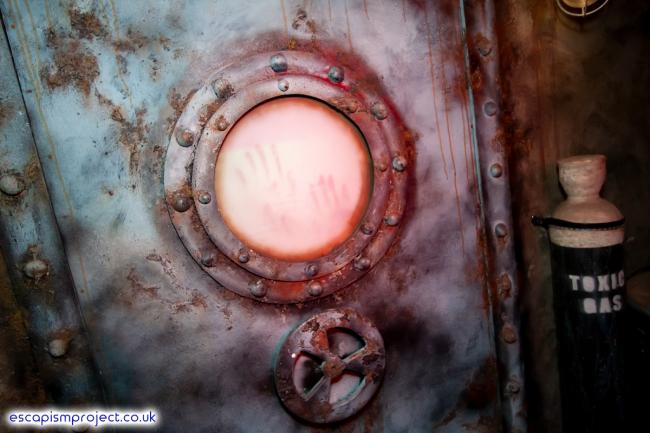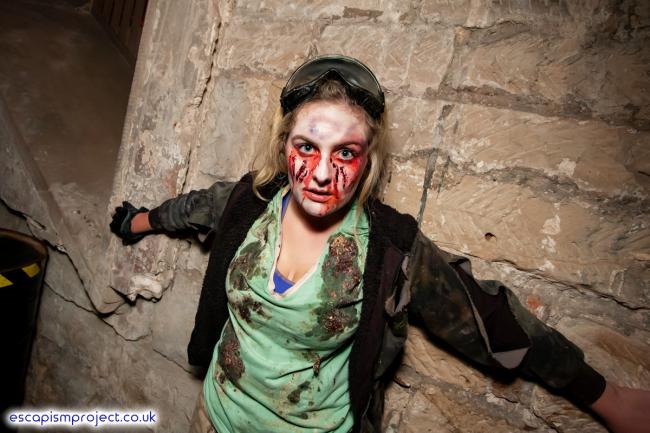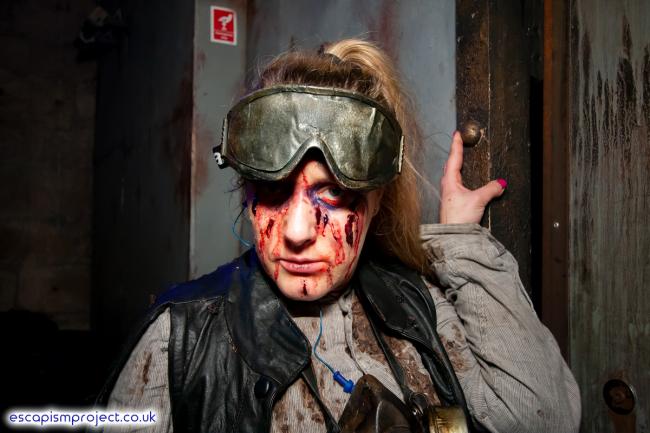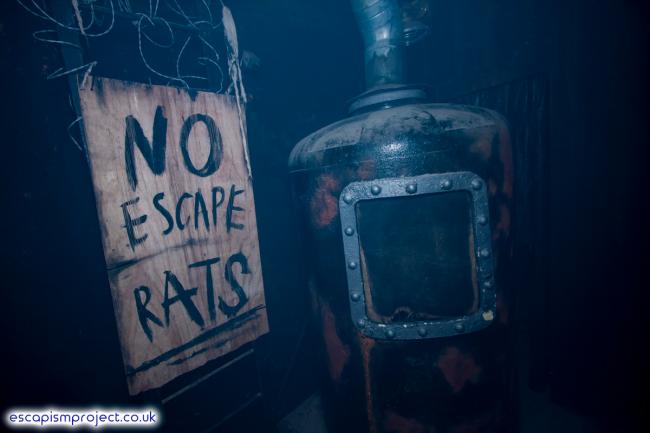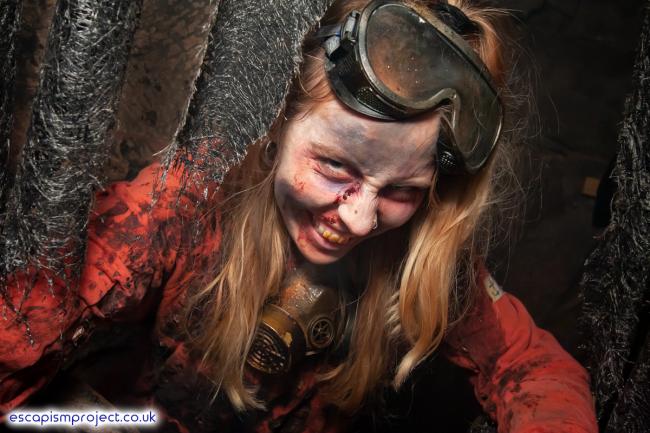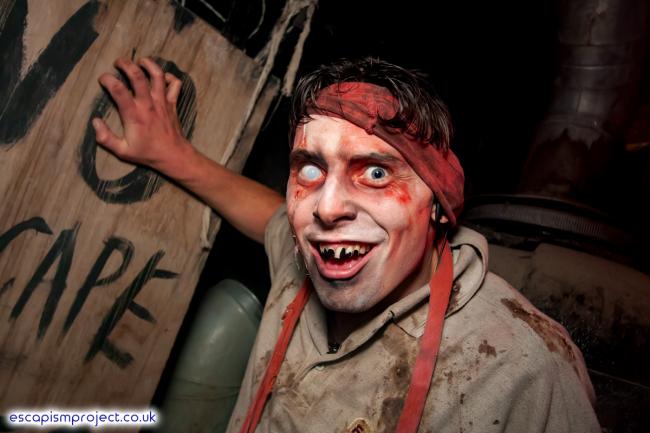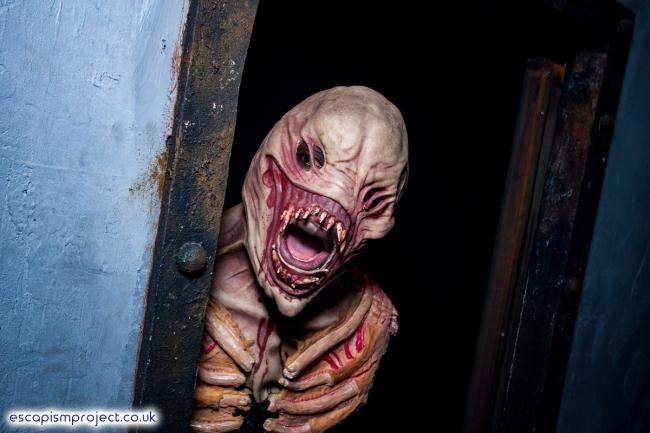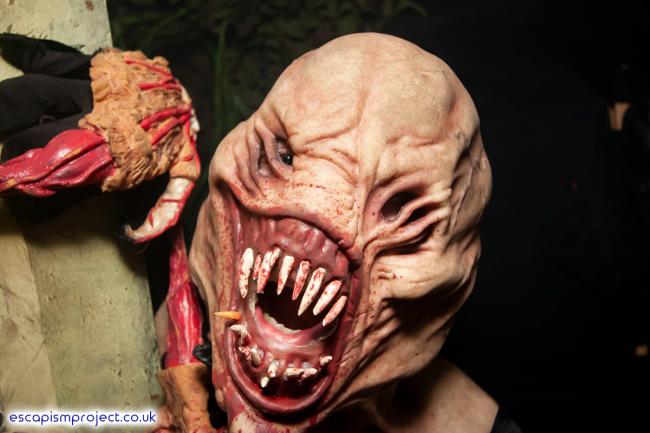
Content Description: Horror, Existentialism and Violence
Originally written October 2020
Let the death race begin…
In the early days of the scare industry, the vast majority of mazes across the United Kingdom required guests to hold onto each other to remain as one, with actors entering personal space without physically touching the group. These rules would be thrown out the window in 2013 when Thorpe Park, who started their creepy career in 2002 with The Freezer, introduced The Cabin in the Woods. Just like the film it was based on, the maze played around with typical terror tropes by negating previous rules about sticking together and contact. Upon entering, guests were greeted with a selection of different routes to explore. It was possible to head in with a big group, yet end up totally alone if you chose a particular path. For the first time, actors were also allowed to lightly grab guests to taunt them further as they endured the cabin’s secrets.
Whilst revolutionary in concept, The Cabin in the Woods had a multitude of issues regarding pacing and guest flow. All too often the first guest in a group would head through one door and the rest would follow as, whilst the hosts made participants aware of the multi-route aspect, actors rarely encouraged it; one route looped back into the first room meaning guests could easily end up going round in circles; certain rooms were awkwardly hidden and too small for load; and, the combination of all routes directing guests out via the same exit and groups going different ways at varying speeds, meant that the finale became clogged with an endless stream of guests. It was an impressive feat with it introducing new concepts, but these issues certainly hindered the experience at times. Despite these flaws, the experimental maze was awarded a SCAR Award for Best Halloween Attraction during the 2014 ScareCON, and would make a huge impact across the scare industry, with many scream parks ditching conga-lines later on.
It wouldn’t be long before Alton Towers would refine this formula and redefine their own mazes with Sub Species: The End Games. Debuting in 2015, Sub Species rewrote their own rules with multiple routes, separation, and some very aggressive physical contact. An instant success, it enjoyed a five year run with it being cited as one of the most intense mazes within a corporate setting.
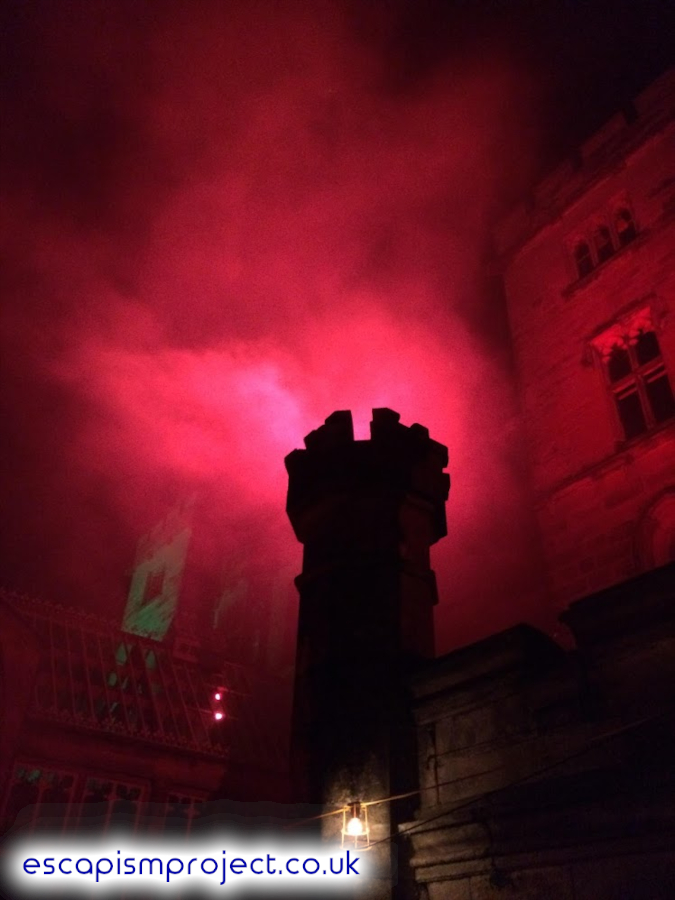
The success of Sub Species was largely due to its extreme uniqueness, but the design itself was a curious one, and a great study of how reputation, flow and proxemics can make or break an experience.
For many seasoned scare addicts, the thought alone of entering Sub Species was enough to instil fear. Even after several runs, there was always a unique tension and sense of foreboding when you made your way over to the entrance. Despite guests knowing they were about to be subjected to something truly terrifying, having entered many times before and always living to tell the tale, there was a wild unpredictability with the maze that made every run as fresh and exciting as the last. Repeat visitors entered, questioning where they would get split, what parts of the maze they would see, and ultimately, how touchy the creatures inside would get. Whilst receiving the pre-maze briefing, many guests felt overwhelmed with a distinct horror; a feeling like they’d made a huge mistake and physically could not enter. Like any good production – be it film or theatre – Sub Species fed of its reputation to excite everyone, whether it be first timers or hardcore fans. Essentially, this meant the maze marketed itself, reaching out to the masses purely through word of mouth.
Just like any other Scarefest maze, Sub Species began with a brief preshow that gave guests a flavour of the story and introduced the inhabitants that lurked within the sewers. The set up here was simple; several monitors displayed “underworlders” sneering and betting on guests survival rates, whilst the largest featured “The Controller”, a menacing, shadowy figure who set up the story. With this being the first true part of the attraction, the atmosphere was stepped up noticeably, alongside a number of subtle effects subconsciously unsettling everyone. All of the characters gave hardened stares towards the guests at all times, and a choppy frame rate on the monitors further decreased comfort. Both were small details that went unnoticed by most, but they increased anticipation and tension exponentially.
A long, loud, foggy corridor followed, bringing the suspense to nearly unbearable levels.
Mere minutes into the maze, it became apparent that the previous rules about contact and separation were absent altogether. Here, an underworlder appeared from the abyss, and pushed a select few guests in front of three “trap” doors. A blackout followed, and when the lights came back, these three guests had seemingly disappeared, having been pulled through the doors and forced through the following Labyrinth in isolation.
The idea of being dragged and handled at random was certainly frightening, but the contact and separation doubled up as both a scare tactic and a utility. On one hand, the prospect of having a bloody brute stroking and separating the group was scary and subversive. Proxemics are the foundation of any theatrical production – mazes included. What separates a maze from any other show is that the actors can get as close as they wish to the audience, whereas a show or ride will have to stay a certain distance away on the stage, or to allow cars clearance. Contact crosses the line of what is acceptable to us in day to day life – here it safely provided a chaotic and unparalleled thrill in the process – but it also enabled the group to be split up, which was an integral part of the experience. Without contact, encouraging friends to temporarily part ways would be near impossible, but having an actor physically pluck them was doable, and deeply unsettling. Separation also assisted the general flow and pace; if a group was slowing down for whatever reason, an actor was able to intervene and lead certain guests elsewhere, reducing the impact of the bottleneck. What was even more incredible is that these techniques also worked in the narrative; thematically it made sense that the underworlders were disorienting contestants to decrease their chances of “winning”. This trilogy of tools created an eerie ecosystem – the fundamentals of Sub Species relied on the separation to both scare and assist flow, all whilst telling the story.
The layout of the attraction itself was large and thoughtfully spread out, with the two-part Labyrinth being the rotten heart of the action. Unlike most walkthroughs, the Labyrinth was a genuine maze, and incredibly easy to get lost in. Taking place in the house’s basement, the majority of the separation took place here, with several intersections between paths, allowing guests to try and find their own way out, with underworlders guiding them the right or, more often that not, wrong way round. One particularly nerve-wracking series of tight corridors had guests looping back on themselves; whilst it was rare for an actor to be lurking here, the high amount of suspense was dreadful.
A smart feature here was the way the maze used rat runs – a network of passages for the actors to traverse the maze without being seen – and the “diamond formation” of actors that surrounded guests. For the most part, participants were between a set of cast members who would emerge from the rat runs to gain a quick scare, or to guide them elsewhere if they crossed paths with another guest.
The decrepit nature of the rooms that housed the majority of the maze also helped further immerse the guest. The Towers Ruins themselves are semi-derelict, with mouldy walls, uneven flooring, and chunks of dust and rubble everywhere. Whilst Alton Towers likely used The Ruins out of convenience, the character of the building felt sympathetic and thematically relevant to Sub Species; the dinginess of the sewers worked effortlessly within the crumbling gothic mansion.
Another great use of the building itself would be the sheer amount of small staircases throughout, with one going down into briefing, one exiting the preshow, and another one following the blackout. The majority of these stairwells would be in whichever maze was located within the lower levels, but it really sold the idea that you were descending deeper into the sewer. This illusion was further reinforced with the lighting in a small room in the southern end of the Labyrinth, where a beautiful beam of light sunk down from a manhole above.
Due to the location of the bulk of the attraction, the final scenes took place in shipping containers adjacent to the main building. Here were two alternate routes; one would take you through a tight crawl space, whilst the other would see guests traversing through a disgusting alien nest. There often wouldn’t be a choice as to which path you would get, meaning if you wanted the full experience, you would have to go round multiple times. You never really knew what you’d encounter in Sub Species; some runs would have aliens clawing after you, whilst others would have you exploring previously unseen areas, making repeat visits all the more entertaining.
Like many other mazes, Sub Species chose to end with a traditional chainsaw chase, but the blocking of this sequence ensured all guests left in a fearful frenzy. Most chainsaw scares involve a long straight corridor, with an actor wielding the power tool coming at you from behind. The issue with this version of the scare is that you know exactly where you’re headed before the chainsaw has revved; all you need to do is speed up and leave. This works for some, but Alton Towers recognised that the vast majority of maze-goers had seen this before, and so decided to place the actor directly in front of the exit. The actor would energetically run towards you rather than from behind, causing guests to jump backwards, having to locate the exit for themselves. Perhaps even more disturbing than this staging was the fact that, on occasion, the actor would lunge the chainsaw onto guests, giving a very memorable last impression.
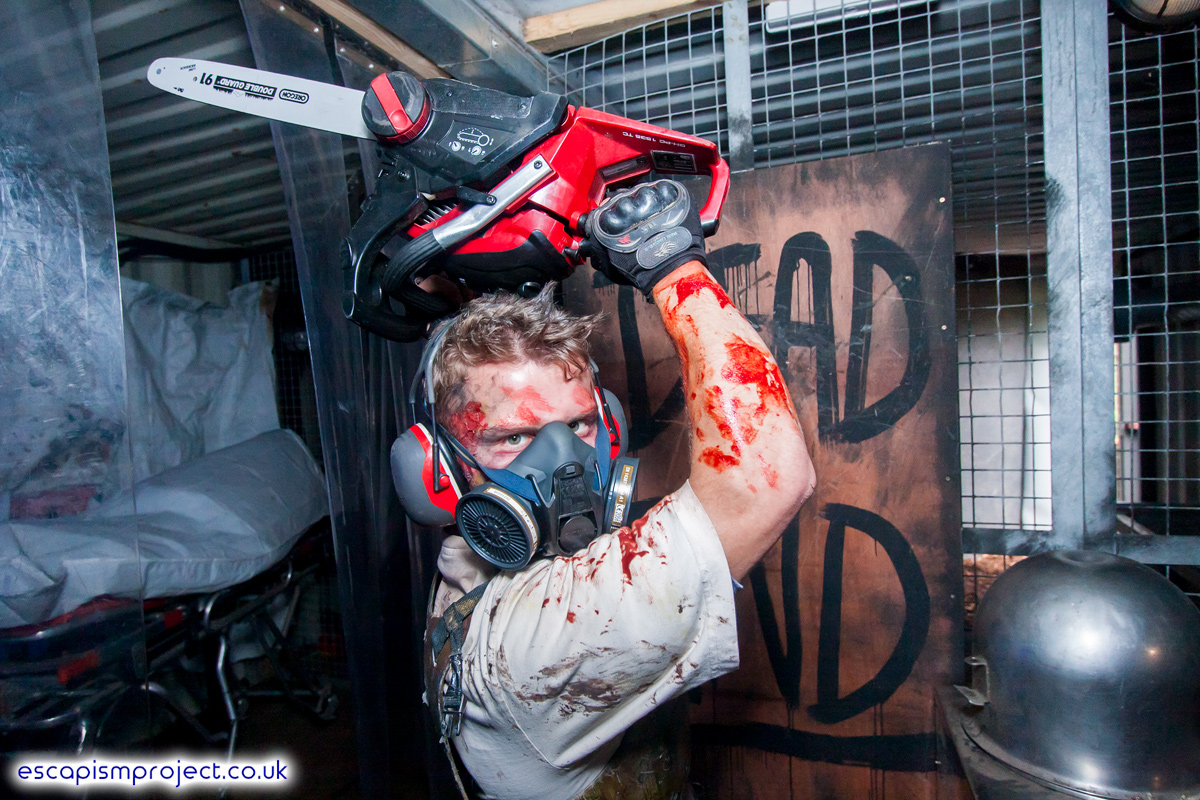
Sub Species will always be renowned for its sheer intensity with constant contact, but it also boasted some of the most interesting world-building and themes of any Scarefest attraction. In a sense, Sub Species was whatever you wanted it to be. If you wanted to invest yourself in the idea of a dangerous game, you were able to converse with the underworlders and fully immerse yourself, but if you just wanted to focus on sharp jump-scares and the energy, then you could power through the maze oblivious to the greater story. Mazes are almost like buffets; you’re free to take as much as you want from them.
Since its debut in 2015, Sub Species has massively influenced the scare industry, and birthed a new generation of mazes at Alton Towers and beyond. Thanks to Sub Species, contact and separation are staples of modern mazes, although we are yet to see an attraction that rivals its fierceness. It took concepts introduced in The Cabin in the Woods and applied a fine level of petrifying polish, and will be fondly remembered as one of the most daring and frightening British mazes of all time with its wild unpredictability, shock horror, and intense intimacy.
Underworlders, betting over…


